Although my hobo-istic tendencies have been slightly truncated with my home base in Peru (where I’ve lived for the last year and a half or so), it hasn’t stymied my desire (nor ability) to continue traveling. Hence, my recent trip to Isla del Sol (island of the sun), on Lake Titicaca, in Bolivia.
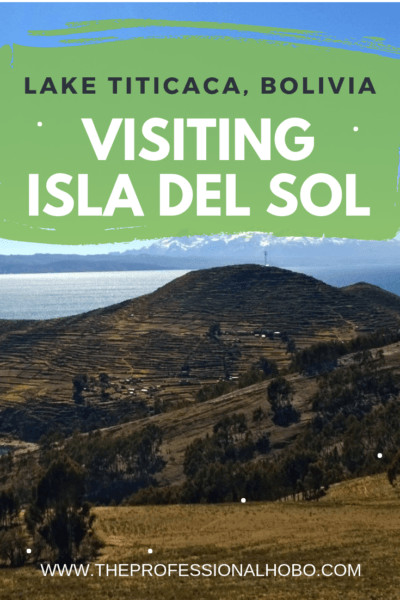
This post was originally published in 2015. It has since been updated for accuracy of links and content.
Getting to Isla del Sol
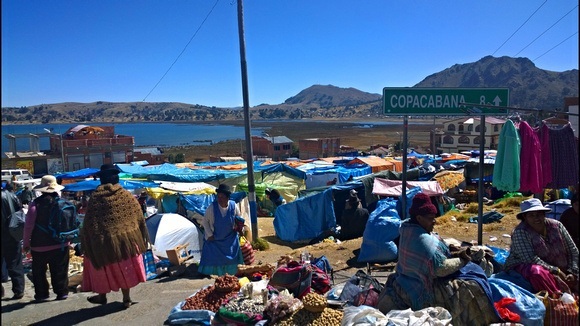
Copacabana (in Bolivia, not to be confused with the beach in Rio de Janeiro) is the launching point to Isla del Sol. It’s just beyond the Peru/Bolivia border, which is about 10 hours from Cusco by bus.
The border crossing itself is an experience. After checking out of one country (eg: Peru), you walk about 200 metres through a busy marketplace to check into the next country (Bolivia). I don’t know what country this “no man’s land” specifically belongs to, but it is a hustle and bustle of people selling everything from fabric to DVDs to plastic tubs to puffed pork fat.
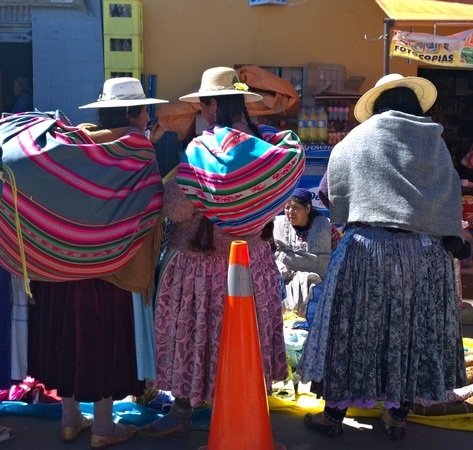
Copacabana itself is a small(ish) town on Lake Titicaca, which has its share of accommodation options, and mainly serves people going to and from Isla del Sol and other islands. (And even though it bears no relation to its sister in Rio, I couldn’t help but sing the famous song about Copacabana repeatedly while I was there – much to my travel partner’s chagrin).
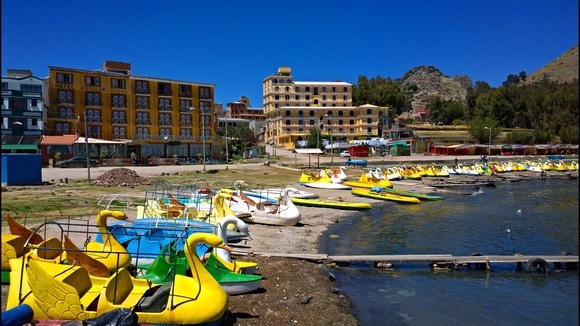
Ferries leave from Copacabana to Isla del Sol 2-3 times per day, and the 1.5 hour ride is a lovely breezy journey.
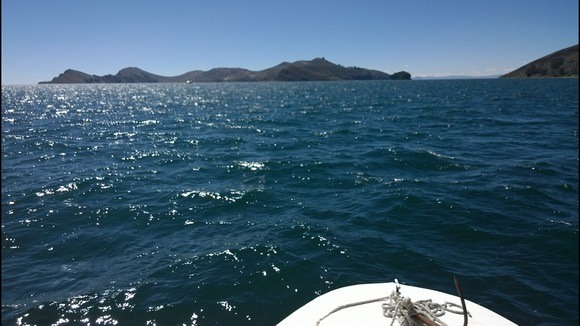
Lake Titicaca
A few words on Lake Titicaca (which again to my partner’s chagrin, I giggled childishly at with every mention of the name): It’s the largest lake in South America, as well as the highest navigable lake in the world – with a surface elevation of over 3,800 metres (12,500 feet).
It is said that Lake Titicaca used be be part of the ocean, some 20 million years ago before the Andes were formed. Although the water isn’t salty any more, it does have an ocean “feel”, with countless vistas of bays that look a bit like the Cote D’Azur.
Arriving at Isla del Sol
There are two main ports of arrival at Isla del Sol: the north, and the south. Most people travel to the south first, which is a shorter ferry ride from Copacabana. From the docks, it’s a (very) steep hike up to the community of Yumani, which is the largest community on Isla del Sol (which has a total population of about 800 families). Yumani isn’t much to look at, but it has its own charm and a very local feel, and offers many places to stay for the night.
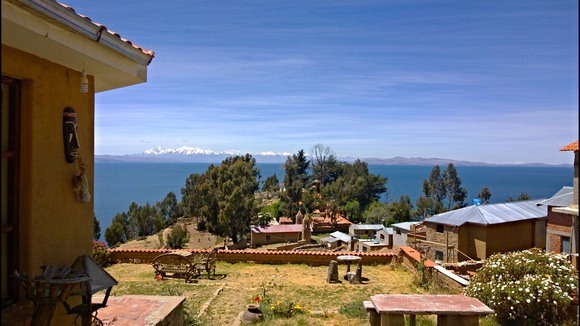
I hiked right through Yumani and stayed just outside of town (and on the trail towards the north part of Isla del Sol) at a beautiful place called Palla Khasa Eco-Lodge with rustic (and sustainable) accommodation and beautiful views.
Hiking to the North
There are no motor vehicles or paved roads on Isla del Sol, but there are lots (and lots) of donkeys. (At times I wondered if there were more donkeys than people living on the island). So between the altitude and the lack of roads, you need to be in fairly good nick to visit Isla del Sol.
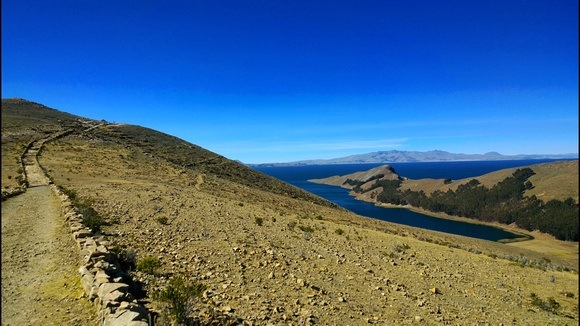
The main event for my trip was to hike to the north part of Isla del Sol and spend the day exploring the sacred ruins before hiking back to the south. Many people start at one side of the island and hike to the other to stay for the night; I did the round trip in one day.
There are over 80 ruins on the island (most of them in the north), dating to the Inca period circa 15th century AD. However there is evidence that people lived on the island as far back as the 3rd millennium BCE.
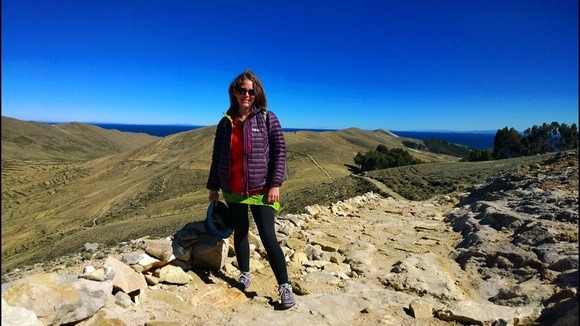
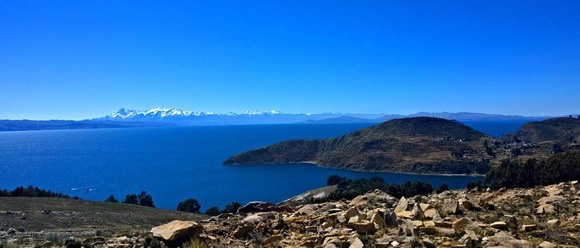
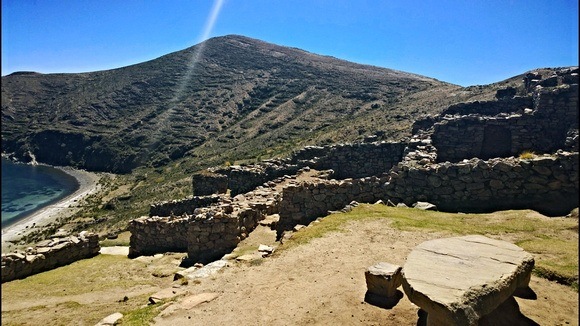
These ruins pictured above (some of the largest on Isla del Sol, in the north) are also known as “the labyrinth”; it doesn’t look like much from the outside, but you can lose yourself in the narrow passages and dark corners. Apparently there is a water source hidden somewhere in there, that has special powers of longevity. (I couldn’t find it; I guess I’m doomed to regular old mortality).
What makes Isla del Sol special (for me) is not only its natural beauty and rustic charm, but also the Incan folklore and historical power and overall energy of the area.
Legend has it that the sun and the moon were born in Lake Titicaca, and that the Incan sun god was born on Isla del Sol. In the aftermath of a great flood, Isla del Sol was the first land that appeared after the waters receded, and the sun emerged from Titi Qala (a sacred spot in the north) to illuminate the sky once again. A temple was built in this spot to honour the sun’s emergence.
My visit was short and sweet (I stayed on the island three nights), but it’s longer than many people passing through seem to stay, who float in for a full-day tour and float back out again. To experience the energy and beauty of the place and people, stick around for a wee bit; you won’t be disappointed.

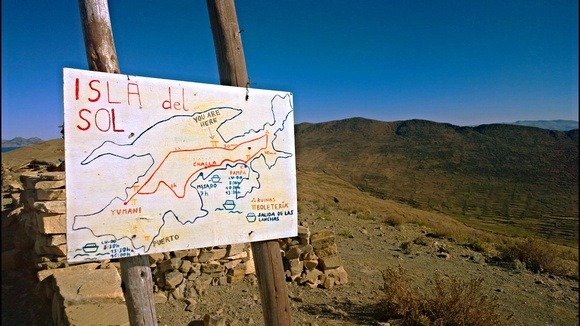

Was there electricity and some sort of internet connection on the island?
Hi Steve,
Yes, there is electricity and internet on the island, just not where I was staying. And like many places in the area, don’t expect the electricity to be entirely reliable, and internet won’t be available everywhere.
For me, it was a lovely retreat away from all things internet. 🙂
How Beautiful Nora. Love those border crossings. So much hustle and bustle in these spots. I recall the crossing between Thailand and Myanmar where all manner of goods are sold, including whole cartons of less than quality cigarettes for $7. Crazy. Not a smoker here but I spoke to one who warned folks of the tar on the cigs. Yikes. Glad you enjoyed your internet fast. Here in Granada it goes in and out for days sometimes so we enjoy Lake Nicaragua and the surrounding jungle in Mombacha. Thanks so much for sharing.
Ryan
Hi Ryan!
I hear you on the internet….where I live in rural Peru it’s less than stellar. Although – pretty reliable on the whole, if not fast. (At least, as reliable as it can be, in a place where the power and other services can go out for no apparent good reason…) Such are the compromises we make to live in these beautiful spots though. Enjoy Granada!
Lovely pictures. I really like the colour of the sky.
I think in Asia and South America the border crossings look similar. There’s always that no-man’s land, that doesn’t belong to anyone, with people running in all directions, sellings things and buying things. It is fascinating to observe.
Hi Jo!
I’d never experienced a border crossing like this, so it’s interesting to hear there are others like it. I quite enjoyed it – indeed, it’s fascinating.
So lovely! Definitely on my short list! Are you back in Arequipa? I’m going to be there for the first time ever and for 2 weeks and I’d love to have a coffee and a chat! 🙂
Hi Jaemy,
I was never in Arequipa (it’s still on my list). I’m in the Sacred Valley of Peru! But enjoy your trip….Peru is awesome, and I hear wonderful things about Arequipa.
Bolivia is a beautiful place to visit!!! incredible pictures
Have you been to Bolivia, Izy? Any favourites or recommendations? I’d still like to visit the salt flats, even though they’re considered a little “over-touristy”.
Beautiful hill & beach…
It’s like another world! I wanted to swim in the water, but it was just too cold to seriously consider.
Beautiful post! I’ve been wanting to do this for quite awhile now. Hopefully next year!
Good luck, Komal. I hope you make it there! It’s beautiful.
Hey Nora, do you know when the ferries return to Copacabana from Yumani and Challapampa?
Hi Andrea,
Ooh, Hmm….You’re testing my memory. I don’t entirely recall, but I seem to remember there being a couple of ferries each day. They’re generally timed so that you can catch the buses departing from Copacabana. Sorry I can’t be of more concrete assistance on this one…
Hi Nora
We are trying to book a 2 nights/3 days tour to copacabana/isla del sol and hike it. How did you manage to stay on the island? are there hotels? or?
Please advise us if you have any recommendations. Why people say to avoid Puno and stay to Copacabana?
Hi Sissy,
Yes, there is accommodation on the island, and if you’re interesting in spending more than a few hours on the island, I highly recommend staying there. There’s a link in the post to the place I stayed (Palla Khasa Eco-Lodge), which was delightful. Most accommodation on Isla del Sol is quite rustic, but lovely.
People advise staying away from Puno because there isn’t much to see in Puno, and from what I gather it’s a fairly dull (and dirty) city. Copacabana is a bit quirkier, and has lots of accommodation options; people either love it or hate it. It’s a bit “touristy”. But the best reason to stay at Copacabana is that it’s right on the lake, and it’s where you pick up the ferry to/from Isla del Sol. So if you are just doing a day trip to the island, it’s best you stay at Copacabana.
Hi Nora,
Thanks for your helpful post. Do you recall whether there are any boats (smaller is fine) going from Yumani to north island once the bigger boats arrive into Yumani? Do you think they can be hired on the spot and leaving at a time that is convenient for us? I’d like to di a little bit of sightseeing / eating before heading to the north island.
Thanks!
Hi Catherine,
I don’t recall, but I suspect that yes, you can take a boat to the north part of the island quite easily.
Enjoy your trip!
Thanks, Nora!
Beautiful hill & beach…